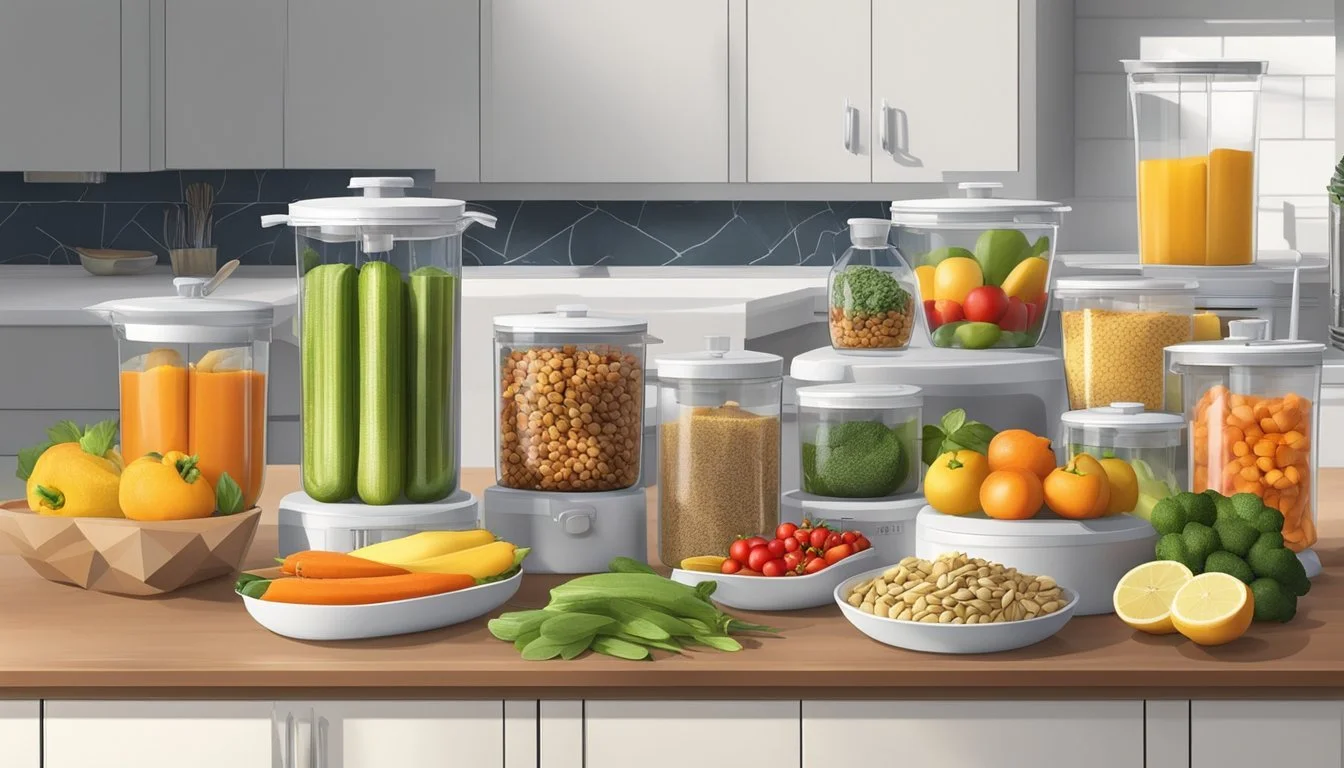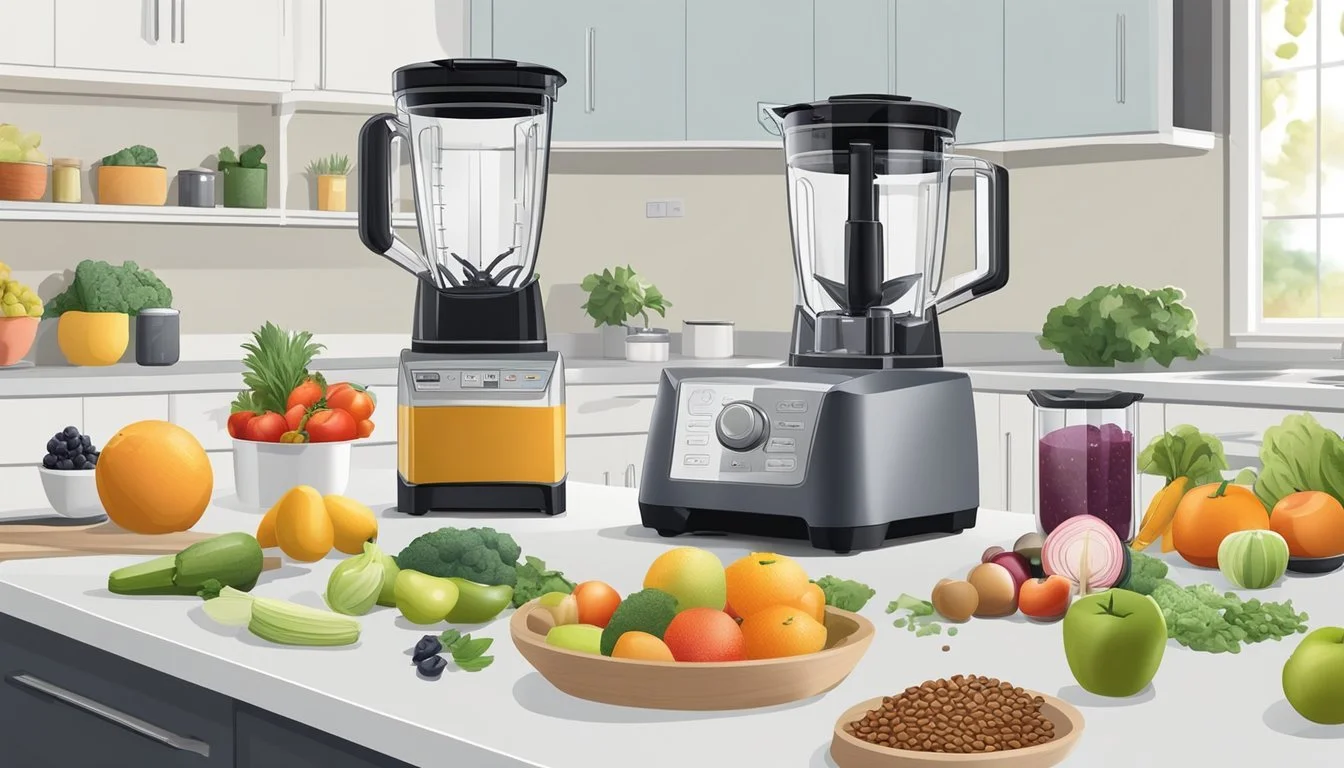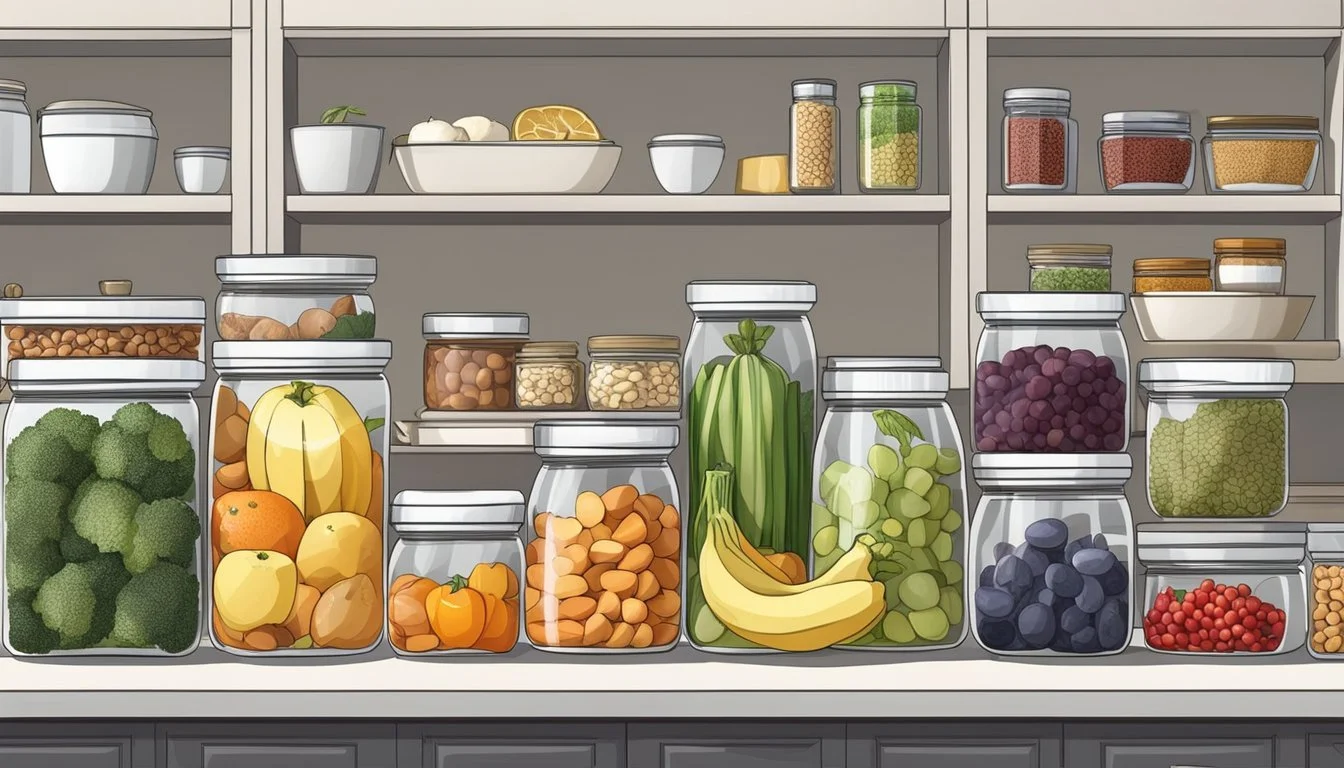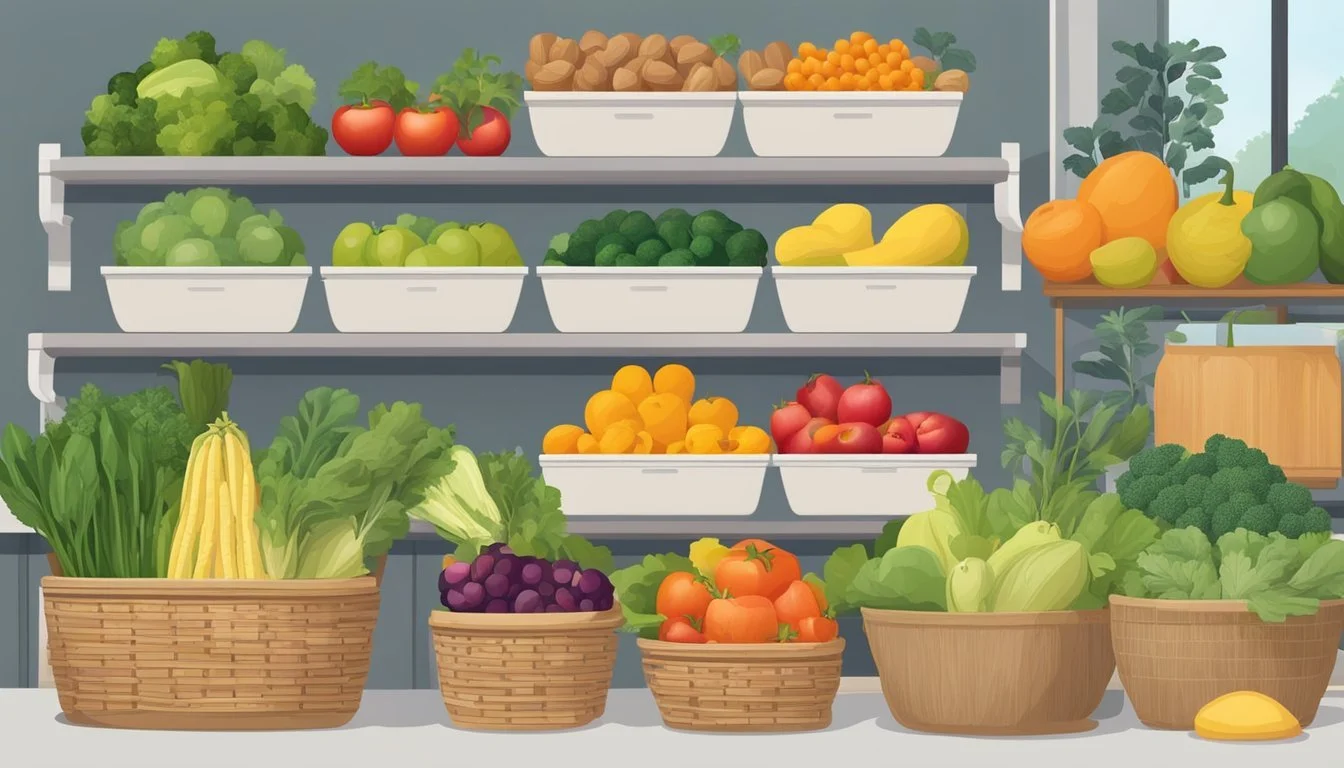Organizing Your Kitchen for a Raw Vegan Diet
Essentials and Layout Tips
Switching to a raw vegan diet entails more than just modifying what one consumes; it calls for a well-thought-out reorganization of the kitchen space to suit the unique demands of this lifestyle. A raw vegan kitchen prioritizes nutrition and freshness, emphasizing the importance of whole, unprocessed plant-based ingredients. To ensure these ingredients maintain their nutritional value and are enjoyable to eat, the kitchen should be equipped with specific tools and arranged to make the preparation of fruits, vegetables, nuts, seeds, and legumes as efficient as possible.
The first step in organizing a kitchen for a raw vegan regimen is to stock it with a variety of raw ingredients that form the base of this nutritional approach. Grains like quinoa and brown rice, although not raw, provide valuable nutrients while offering diversity in meals; other staples such as oats, chickpeas, black beans, and an array of nuts and seeds like almonds and flaxseeds are fundamental. Fresh produce should be at the forefront, ensuring there is a plentiful supply of fruits and vegetables ready to be transformed into nutritious meals.
Change in one's kitchen also involves assembling an array of kitchen tools designed to handle the tasks specific to a raw vegan diet. Items such as a high-powered blender, food processor, and a quality set of knives are essential for preparing everything from smoothies to zucchini noodles. Strainers and sprouting jars become important for soaking and sprouting to enhance digestibility and nutrient access. Together, these tools and an organized pantry set the stage for a successful and enjoyable raw vegan lifestyle.
Essentials of a Raw Vegan Diet
Embarking on a raw vegan diet involves selecting a variety of plant-based foods that are uncooked and unprocessed. The essentials in this lifestyle focus on maximizing nutrition, incorporating healthy proteins, iron, and energy sources, as well as ensuring a high intake of fiber for optimal health benefits.
What Is a Raw Vegan Diet?
A raw vegan diet consists of uncooked, plant-based foods that have not been heated above approximately 118 degrees Fahrenheit (48 degrees Celsius). This dietary choice includes a variety of fruits, vegetables, nuts, seeds, grains, and legumes, which are consumed in their most natural state.
Foods typically included:
Fruits: All types, fresh or sun-dried
Vegetables: Leafy greens, roots, and others
Nuts & Seeds: Almonds, chia, flaxseeds
Grains & Legumes: Sprouted or soaked
Benefits of Raw Veganism
Individuals may pursue a raw vegan diet for its potential health benefits, which include a lower risk of chronic diseases such as Type 2 diabetes and high blood pressure. The diet is rich in nutrients and is believed to retain more natural vitamins and minerals due to the absence of cooking, which can sometimes diminish nutritional content.
Key benefits include:
High Fiber: Aids in digestion and satiety
Antioxidants: Helps combat oxidative stress
Enzymes: Preserved in uncooked foods for better digestion
Nutritional Considerations
While a raw vegan diet is abundant in vitamins, minerals, and fiber, special attention must be paid to ensure sufficient protein and iron intake. Diverse food combinations are necessary to cover the full spectrum of amino acids and to maintain adequate energy levels.
Nutrition essentials:
Protein: Hemp seeds, sprouted lentils, spirulina
Iron: Leafy greens, legumes, nuts, and seeds
Calcium & Vitamin D: Fortified plant milks, mushrooms
B12: Supplements are often recommended
Proper planning and knowledge are paramount for maintaining a balanced raw vegan diet that supports a person's overall health and wellness.
Setting Up Your Raw Vegan Kitchen
Setting up a raw vegan kitchen involves having the right tools and ingredients to prepare nutritious and vibrant meals. It's important to effectively utilize kitchen spaces like the pantry, refrigerator, and freezer and to choose kitchen tools that will make raw food preparation both simple and efficient.
Essential Kitchen Tools
A well-equipped kitchen is crucial for successful raw vegan cooking. Key tools include:
Knives: A chef's knife and a paring knife for precise chopping.
Blender: High-speed for smoothies and soups.
Food Processor: For preparing nut butters and pâtés.
Spiralizer: For creating vegetable noodles.
Dehydrator: Optional, for making raw crackers or fruit leathers.
Strainer: To wash and prepare seeds, nuts, and grains.
Pantry Staples
Maintaining a stocked pantry ensures one always has the base ingredients for raw vegan recipes:
Whole Grains: Quinoa and brown rice.
Legumes: Lentils and chickpeas.
Nuts: Almonds and walnuts, for energy and crunch.
Seeds: Chia seeds and flaxseeds, for their omega-3 content and versatility.
Oils: Extra virgin olive oil and coconut oil for dressings and raw desserts.
Nut Butters: Such as almond butter for snacking and sauces.
Sweeteners: Agave nectar or dates for natural sweetness.
Condiments: Miso paste for umami flavor and sea salt for seasoning.
Optimizing Your Refrigerator
The refrigerator should be organized to preserve the freshness of produce and to have ready-to-eat raw food items:
Produce: Store fresh fruits and vegetables in climate-controlled drawers.
Coconut Milk: Keep a can on hand for creamy smoothies or desserts.
Pre-Prepared Ingredients: Cut vegetables and soaked nuts for easy snack and meal assembly.
Herbs and Greens: Separate to prevent flavor transfer and wilting.
Freezer Management
The freezer can extend the life of many raw vegan ingredients, and it's perfect for batch prepping:
Fruits: Freeze berries and bananas for cold desserts or smoothies.
Nuts/Seeds: Store extra nuts and seeds to maintain their freshness.
Energy Bites: Prepare in batches and freeze for a quick snack.
Leafy Greens: Freeze spinach or kale for use in green smoothies.
Planning Your Meals
Effectively organizing a kitchen for a raw vegan diet requires a thoughtful approach to meal planning. By crafting a balanced meal plan, preparing ingredients in advance, and having a variety of recipes at hand, one can ensure a diverse and nutritious diet.
Creating a Balanced Meal Plan
A balanced meal plan should include a variety of fruits, vegetables, nuts, seeds, and legumes to ensure that all nutritional needs are met. Each day, individuals should aim for a colorful array of foods to maximize their intake of vitamins, minerals, and enzymes. For instance:
Breakfast might consist of a smoothie made with kale, bananas, and chia seeds, or a fruit salad topped with a dressing of blended orange juice and dates.
Lunch could feature lettuce boats filled with a mix of sliced avocado, julienne carrots, and sprouted legumes, complemented by a dollop of homemade lemon-tahini dressing.
Dinner might showcase a savory cauliflower rice adorned with a medley of raw vegetables such as bell peppers, zucchini, and topped with cold-pressed olive oil.
Batch Cooking and Prepping
Though "cooking" per se isn't a part of a raw vegan diet, batch prepping is invaluable for efficiently managing meals throughout the week. Key activities might include:
Soaking nuts and seeds overnight to enhance their digestibility.
Preparing versatile components like date paste, nut butter, and tahini dressing to use throughout the week.
Chopping and storing vegetables in air-tight containers to maintain freshness and expedite meal assembly.
Raw Vegan Recipes and Ideas
Expanding one's repertoire of raw vegan recipes prevents dietary monotony. Here are some recipe ideas:
Salads: Combine mixed greens with an assortment of chopped veggies, sprouted beans, and a generous sprinkle of hemp seeds. Finish with a drizzle of homemade avocado dressing.
Soups: Puree ripe tomatoes with red bell peppers, cucumbers, and fresh basil to create a refreshing gazpacho that bursts with flavor.
Juices: Start the day with a vibrant juice made from carrots, apples, ginger, and lemon for a revitalizing boost.
Snacks: Create raw energy balls from dates, almonds, and coconut shavings for a nutritious pick-me-up.
Selecting and Storing Produce
Starting a raw vegan diet requires special attention to how one selects and stores fruits and vegetables to maintain freshness and nutrient content.
Choosing Fresh Vegetables and Fruits
When selecting vegetables and fruits, shoppers should focus on the freshness and ripeness of produce to ensure maximum nutrients and flavor. Apples and mangoes should be firm with smooth skin, free from bruises or wrinkles. Tomatoes should be slightly soft to touch with a deep color, indicating they are ripe and flavorful. Selecting garlic involves looking for plump, unbroken bulbs, whereas fruits like lemons and limes are best chosen when heavy for their size, suggesting juiciness.
For maximum health benefits, it is advisable to consider the variety of vegetables and fruits, incorporating a range from leafy greens to bright berries like goji berries. Dates should be plump and sticky, indicating freshness. For year-round nutrition, frozen berries and vegetables can be a good substitute when fresh produce is not available.
Proper Storage Techniques
The longevity and taste of produce depend significantly on proper storage techniques. It is crucial to understand that not all produce should be stored in the same environment.
Vegetables:
Leafy greens: Store in the refrigerator's crisper drawer, loosely wrapped in a damp cloth.
Garlic: Keep in a cool, dark place with ample air circulation.
Tomatoes: Best kept at room temperature away from direct sunlight to preserve flavor and texture.
Fruits:
Apples: Refrigerate away from other produce to prevent ethylene gas from hastening the ripening of sensitive vegetables.
Mangoes: Ripen on the counter, then refrigerate once ripe to prolong freshness.
Citrus fruits (lemons, limes): Store in the refrigerator drawer to extend shelf life.
Dates and goji berries: Store in airtight containers; keep dates at room temperature and goji berries in the fridge to prevent moisture from spoiling them.
Utilizing containers that promote humidity control can assist in keeping produce fresh longer. Remember that some fruits and vegetables emit ethylene gas, which can accelerate ripening and should be stored separately. Regularly check for and remove any spoiled items to prevent the spread of mold or spoilage to other produce.
Raw Vegan Ingredients and Substitutes
Preparing a raw vegan kitchen involves understanding the right substitutes for common ingredients. This section explores protein options, fats and oils, and natural sweeteners and flavorings.
Alternative Sources of Protein
Vegans do not consume animal products, so they obtain protein from plants. In a raw vegan diet, common protein sources include:
Legumes: Soaked or sprouted lentils and chickpeas.
Nuts and Seeds: Almonds, cashews, chia seeds, flax seeds, and hemp seeds are excellent for their protein content.
Grains: Quinoa and oats provide a considerable amount of protein.
Others: Nutritional yeast and tahini are versatile ingredients that can boost the protein content of meals.
Healthy Fats and Oils
Essential fatty acids are vital for health, and raw vegans can get these nutrients from several sources:
Nuts and Seeds: Almonds and cashews, in their raw form or as homemade nut butter, are good fats.
Seed Oils: Cold-pressed oils from flax or hemp seeds.
Avocado and Coconut: Avocadoes and raw coconut flesh or oil offer healthful fats.
Natural Sweeteners and Flavorings
Going raw vegan doesn't mean one must give up on sweetness or flavors. Here are some raw substitutes:
Sweeteners: Maple syrup is a prevalent natural sweetener, as well as raw agave nectar.
Spices: Fresh or dried spices, such as cinnamon or vanilla pods, add depth without artificial additives.
Raw almond milk can be used in place of dairy milk for a natural, subtle sweetness.
Enhancing Flavor Without Cooking
To thrive on a raw vegan diet, one's kitchen needs to be prepared to enhance flavor without the application of heat. This section provides a strategic approach to using herbs, spices, and raw culinary techniques to create rich flavors in raw dishes.
The Role of Herbs and Spices
Herbs and spices are integral to adding complexity and depth to raw vegan dishes. Cinnamon, with its warm, sweet characteristics, can transform a simple fruit dish into a dessert-like experience. Garlic and ginger offer pungent notes that heighten savory dishes without the need for cooking, while oregano and sage deliver a robust taste that's reminiscent of Italian or Mediterranean cuisine. Raw dishes economically utilize these components to substitute the flavors one may miss from cooked foods.
Cinnamon: Add to sweet dishes, smoothies, or sprinkle over fruits.
Garlic: Mince freshly in salads or make a garlic-infused oil.
Ginger: Grate into dressings or mix into juice blends.
Oregano & Sage: Blend into sauces or toss with salads for an aromatic kick.
Creating Raw Vegan Sauces and Dips
Sauces and dips are the secret weapons in a raw vegan's arsenal, providing creamy or zesty companions to a range of vegetables and fruits. Hummus, made with chickpeas, lemon, garlic, and tahini, serves as a hearty dip or spread. For a sweeter edge, dates or citrus juices can emulsify ingredients into a pleasing texture, while nuts and seeds ground into sauces bring forth a luxurious richness.
Hummus: Puree chickpeas, tahini, lemon juice, and garlic for a classic dip.
Fruit-based sauces: Blend fresh dates, citrus juice, or apple cider vinegar with fruits for a sweet sauce.
Seasoning Blends for Raw Dishes
Pre-mixed seasoning blends can greatly simplify the preparation process while consistently delivering flavor. A combination of onion powder, smoked paprika, and sea salt, for example, can produce a savory mix ideal for sprinkling on tomato slices or avocado. Nutmeg, although often associated with sweet dishes, can add an interesting depth to savory seasoning blends.
Savory:
Onion powder: Partner with sea salt for a simple vegetable seasoning.
Smoked paprika: Apply liberally to create a smoky depth in salads or dips.
Sweet:
Nutmeg: Dash on fruits or into raw dessert recipes for a warm spice note.
Supplementing Your Diet for Complete Nutrition
In embarking on a raw vegan diet, it is essential to ensure one's nutritional needs are met through careful supplementation, especially for nutrients that might be less abundant in plant-based and uncooked foods.
Vitamins and Minerals to Consider
One should be mindful of specific vitamins and minerals when adopting a raw vegan diet. Iron is critical for oxygen transport in the blood, and plant sources include spinach, cashews, and lentils. However, plant-based iron is not as easily absorbed as the iron from animal products, making it helpful to consume vitamin C-rich foods like citrus fruits alongside iron-rich foods to enhance absorption.
Vitamin B12 is another nutrient that can be lacking in a vegan diet as it is not found naturally in plant foods. Vegans may need to consider B12-fortified foods or a B12 supplement to maintain healthy nerve function and blood cells.
Superfoods and Nutritional Boosts
Superfoods such as hemp seeds, sunflower seeds, and pumpkin seeds provide a substantial boost in protein, omega-3 and omega-6 fatty acids, which are crucial for brain health and reducing inflammation. Almonds and walnuts also contribute beneficial fats, proteins, and additional minerals.
Sourcing Quality Supplements
When selecting supplements, quality should not be compromised. Seek out reputable brands that provide transparency regarding their sourcing and production methods. This ensures that supplements are free from contaminants and that they provide the stated nutritional benefit. It's also advisable to opt for whole food-based supplements when possible, as they can be more easily recognized and utilized by the body.
Kitchen Organization and Maintenance
Effective kitchen organization and maintenance streamline the raw vegan food preparation process while ensuring a sanitary workspace. These principles foster an environment that enhances both workflow and cleanliness.
Workflow and Space Efficiency
A well-organized kitchen maximizes spatial efficiency, ensuring ingredients and tools are easily accessible. Storage Solutions include:
Clear, labelled containers for raw vegan staples like seeds and nuts
Drawer dividers for utensils to separate spatulas, knives, and measuring tools
A designated preparation area, ideally a clear counter space near cutting tools and bowls
Vertical Space Utilization can dramatically increase workable kitchen area:
Use wall-mounted racks for hanging pots and utensils
Employ stackable racks for organizing dishes and cutting boards
Maintaining Cleanliness and Hygiene
Regular maintenance prevents the spread of bacteria and maintains food safety standards in a raw vegan kitchen. Essential practices include:
Daily Cleaning Tasks: Wipe down surfaces with food-safe disinfectants after each use and clean cutting boards thoroughly to avoid cross-contamination.
Deep Cleaning Routine: Schedule weekly deep cleans of appliances and monthly inspections of the pantry to check for expired products.
Organization of Cleaning Supplies should prioritize accessibility and segregation:
Store eco-friendly cleaning agents in a caddy under the sink or in a dedicated closet
Keep sponges, brushes, and cloths separate from food storage areas to prevent contamination
Overcoming Challenges and Staying Motivated
Transitioning to a raw vegan diet demands significant changes in how one organizes their kitchen and approaches eating. Planning, persistence, and resources are vital to managing these shifts without losing the drive to continue on this path.
Dealing with Cravings
Cravings are a natural response when individuals amend their diets. One can manage these by preparing a variety of raw vegan snacks in advance to satiate different taste buds. For sweetness, having dates or frozen bananas ready can curb sugar cravings. Salty urges might be mitigated with seasoned nuts or kale chips. Gradual substitutions, introducing raw options like zucchini noodles, help ease the change.
Eating Raw Vegan on a Budget
A common misconception is that eating raw vegan is excessively expensive. However, strategic shopping and meal planning can be budget-friendly. One can:
Buy in bulk: Grains, nuts, and seeds are often less expensive when purchased in larger quantities.
Seasonal produce: Opt for fruits and vegetables that are in season to reduce costs.
Grow your own: Starting a small herb garden or a balcony vegetable patch can supply fresh ingredients at a minimal investment.
Community and Support
Building a support system is crucial to maintain motivation. Connecting with local or online raw vegan communities can provide emotional support, knowledge sharing, and encouragement. They may organize potlucks, workshops, or swap meets where one can expand their dietary horizons and feel less isolated in their dietary choices.
Continuing Education and Inspiration
Educating oneself about raw veganism can bolster commitment and provide new culinary ideas. There are numerous resources available that provide recipes, nutritional information, and the benefits of a raw vegan lifestyle. Books, documentaries, and cooking classes are excellent sources of continuous learning and inspiration, keeping the diet diverse and interesting.










